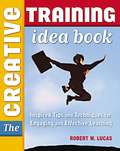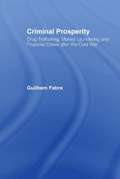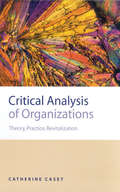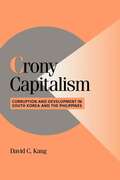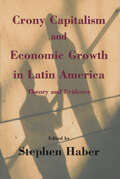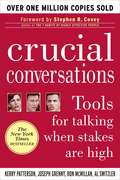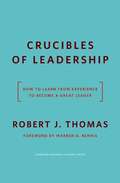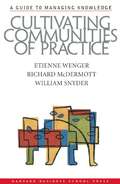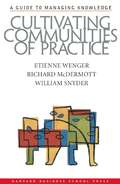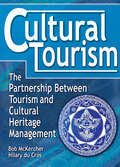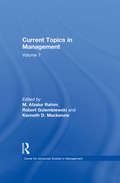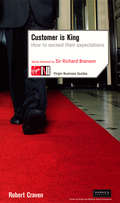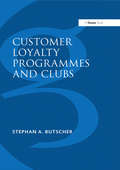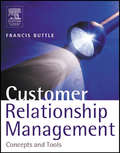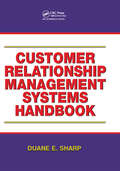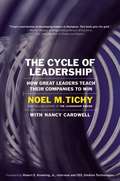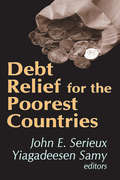- Table View
- List View
The Creative Training Idea Book: Inspired Tips and Techniques for Engaging and Effective Learning
by Robert W. LucasTrainers have to be creative if they want their participants to feel excited, challenged, and involved. The Creative Training Idea Book is packed with instructions for using activities, games, puzzles, toys, and props to increase energy and active participation in the classroom, and reveals how to think creatively about training in any situation.Based on the author’s nearly three decades of training experience, this invaluable resource gives trainers the tools to adopt a fun, energetic approach that will make for a stimulating learning environment. Readers will learn new methods for:* setting the right tone* uncovering participant needs* grouping participants and selecting leaders* avoiding and reclaiming turned-off learners* encouraging and rewarding participation* and much more!Filled with checklists, forms, resources, and dozens of ""Bright Idea"" blurbs, The Creative Training Idea Book will help trainers and their learners achieve maximum learning results.
Creativity in product innovation
by Jacob Goldenberg David MazurskyCreativity in Product Innovation describes a remarkable technique for improving the creativity process in product design. Certain 'regularities' in product development are identifiable, objectively verifiable and consistent for almost any kind of product. These regularities are described by the authors as Creativity Templates. This book describes the theory and implementation of these templates, showing how they can be used to enhance the creative process and thus enable people to be more productive and focused. Representing the culmination of years of research on the topic of creativity in marketing, the Creativity Templates approach has been recognised as a breakthrough in such journals as Science, Journal of Marketing Research, Management Science, and Technological Forecasting and Social Change. It has been successfully implemented through workshops in international companies including Philips Consumer Electronics, Ford Motor Co. , Ogilvy & Mather Worldwide, Kodak, Coca-Cola and many others.
Criminal Prosperity: Drug Trafficking, Money Laundering and Financial Crisis after the Cold War
by Guilhem FabreDrug trafficking is the most visible part of the profits of organized crime, which have grown considerably since the end of the cold war. The mirror of history shows us the impact of the drug trade in the colonization of Asia. The post cold war geopolitical context reproduces elements of the past, with new opportunities for drug trafficking in the globalization process, as can be seen in the example of China, and the lasting impunity in terms of money laundering. With the growing role of offshore locations in the global financial system, criminal prosperity has even affected the economic stability of some countries. This book presents a new and heterodox interpretation of the post cold war financial crisis, by focusing on the unexplored dimension of illicit actors. The Mexican crisis of 1994 and its 'tequila effect' is analyzed as a model of a 'cocaine effect' from the local laundering of profits from the sale of drugs in the US. The Japanese crisis of the 1990s is put in relation to the economic influence of the Yakuza on the real estate bubble, which had the effect of postponing necessary market adjustments. And the Thai crisis of 1997 is analyzed in the light of massive money laundering of institutional and criminal networks, whose undeclared profits represent about 10% of GDP.
Critical Analysis of Organizations: Theory, Practice, Revitalization
by Catherine Joan Casey`Catherine Casey has written an excellent book that provides a lucid and comprehensive critical analysis of organizations....[It] extends in reach and relevance beyond the specific field of organization studies and the sociology of organizations to encompass broader intellectual developments that have had a significant impact on contemporary sociology and cultural studies' - Barry Smart, Professor of Sociology, University of Portsmouth `I anticipate that it will prove to be an attractive book in organization studies, industrial sociology and general sociology. I am sure that this will be a book that will make a major impact' - Mike Reed, Professor of Organization Theory, Lancaster University In this comprehensive and scholarly book, the essential critical strands in organizational analysis are explained. It examines how central traditions have realigned in relation to the challenge of postmodernism and the new reflexive turn in organizational studies. Judicious, innovative and written with the needs of students in mind, this book offers a renewed and revitalized critical accent in organization studies - one that focuses on existing and emerging social tendencies, contestations and struggles. It will be essential reading for senior students of organization studies and sociology.
Crony Capitalism: Corruption and Development in South Korea and the Philippines (Cambridge Studies in Comparative Politics)
by David C. Kang Robert H. Bates Ellen Comisso Peter Lange Joel Migdal Helen MilnerWhy has the literature on Asian development not addressed the issue of money politics in Korea? How can we reconcile the view of an efficient developmental state in Korea before 1997 with reports of massive corruption and inefficiency in that same country in 1998 and 1999? Politics is central to the answer. <p><p>In this book the author makes two arguments. First, both Korea and the Philippines experienced significant corruption throughout the post-independence era. Second, political - not economic - considerations dominated policy making in both countries. Focusing on the exchange of favors for bribes between state and business, the author argues that politics drove policy choices, that bureaucrats were not autonomous from political interference in setting policy, and that business and political elites wrestled with each other over who would reap the rents to be had. Even in Korea, corruption was far greater than the conventional wisdom allows.
Crony Capitalism and Economic Growth in Latin America: Theory and Evidence
by Stephen HaberCrony capitalism systems—in which those close to political policymakers receive favors allowing them to earn returns far above market value—are a fundamental feature of the economies of Latin America. Haber and his expert contributors draw from case studies in Mexico, Brazil, and other countries around the world to examine the causes and consequences of cronyism.
Crucial Conversations
by Vineeta Vijayaraghavan Thomas J. DelongTodd McKenna, a third-year associate at an investment banking firm, confronts his boss. His boss had told him he would be the top paid associate at the firm, and McKenna finds out that this isn't true. He approaches his boss to find out why he was lied to.
Crucial Conversations: Tools for Talking When Stakes Are High
by Kerry Patterson Joseph Grenny Ron Mcmillan Al Switzler Stephen R. CoveyFour cofounders of a corporate consulting firm present their formula for effective communication, based on the trial and error of years spent as corporate trainers. The reader is drilled not only in communication skills but also to recognize bad or shifty modes of communication, to develop integrity in word and deed, and to achieve more effective work habits. Annotation c. Book News, Inc., Portland, OR (booknews.com)
Culinary Essentials
by Johnson Wales UniversityOpen foodservice career pathways with this outstanding new program! Packed with great charts and extraordinary full-color illustrations, this text provides a current and practical view of the culinary workplace.
Cultivating Communities of Practice: A Guide to Managing Knowledge
by Etienne Wenger Richard A. Mcdermott William SnyderIn order to find out how to make the best use of the knowledge that a company's employees possess, the authoring consultants lift models from Xerox, Daimler Chrysler and the World Bank to show how to tap into the wisdom within.
Cultivating Communities of Practice
by William Snyder Etienne Wenger Richard A. McdermottToday's economy is fueled by knowledge. Every leader knows this to be true, yet few have systematic methods for converting organizational knowledge into economic value. This book argues that communities of practice--groups of individuals formed around common interests and expertise--provide the ideal vehicle for driving knowledge-management strategies and building lasting competitive advantage. Written by leading experts in the field, Cultivating Communities of Practice is the first book to outline models and methods for systematically developing these essential groups. Through compelling research and company examples, including DaimlerChrysler, McKinsey & Company, Shell, and the World Bank, authors Etienne Wenger, Richard McDermott, and William M. Snyder show how world-class organizations have leveraged communities of practice to drive strategy, generate new business opportunities, solve problems, transfer best practices, develop employees' professional skills, and recruit and retain top talent. Underscoring the new central role communities of practice are playing in today's knowledge economy, Cultivating Communities of Practice is the definitive guide to fostering, designing, and developing these powerful groups within and across organizations.
Cultural Tourism: The Partnership Between Tourism and Cultural Heritage Management
by bob Mckercher hilary du crosExamine cultural tourism issues from both sides of the industry!Unique in concept and content, Cultural Tourism: The Partnership Between Tourism and Cultural Heritage Management examines the relationship between the sectors that represent opposite sides of the cultural tourism coin. While tourism professionals assess cultural assets for their profit potential, cultural heritage professionals judge the same assets for their intrinsic value. Sustainable cultural tourism can only occur when the two sides form a true partnership based on understanding and appreciation of each other's merits. The authors--one, a tourism specialist, the other, a cultural heritage management expert--present a model for a working partnership with mutual benefits, integrating management theory and practice from both disciplines.Cultural Tourism is the first book to combine the different perspectives of tourism management and cultural heritage management. It examines the role of tangible (physical evidence of culture) and intangible (continuing cultural practices, knowledge, and living experiences) heritage, describes the differences between cultural tourism products and cultural heritage assets, and develops a number of conceptual models, including a classification system for cultural tourists, indicators of tourism potential at cultural and heritage assets, and assessment criteria for cultural and heritage assets with tourism potential. Cultural Tourism examines the five main constituent elements involved in cultural tourism: cultural and heritage assets in tourism sites such as the Royal Palace in Bangkok, the Cook Islands, and Alcatraz Prison in San Francisco. tourism--what it is, how it works, and what makes it a success five different types of cultural tourists consumption of products, value adding, and commodification integrating the first four elements to satisfy the tourist, meet the needs of the tourism industry, and conserve the intrinsic value of the assetThough tourism and cultural heritage management professionals have mutual interests in the management, conservation, and presentation of cultural and heritage assets, the two sectors operate on parallel planes, maintaining an uneasy partnership with surprisingly little dialogue. Cultural Tourism provides professionals and students in each field with a better understanding of their own roles in the partnership, bridging the gap via sound planning, management, and marketing to produce top-quality, long-lasting cultural tourism products.Now translated into simplified Chinese.
Culture: A Force for Alignment
by Jay W. Lorsch Thomas J. TierneyThe firms that endure manage their culture to minimize the stress of change, turn to it as a reminder of their course in the face of new challenges, and work to change it to adapt to new circumstances. This chapter focuses on culture as central to shaping behavior and attracting and retaining stars, and discusses how it can be--and must be--managed.
Current Topics in Management: Volume 7 (Center for Advanced Studies in Management)
by M. Afzalur Rahim Robert T. Golembiewski Kenneth D. MackenzieThis annual series presents fundamental research on the theory and practice of management. Volume 7 contains articles presented at the 2001 meeting of the International Conferences on Advances in Management (ICAM), held in Athens, Greece. ICAM's goal is to be truly comparative-in terms of the broad scope of management perspectives, in the broad-ranging locations of its research as well as its application, and in its comparisons of findings, methodologies, and operational definitions. This volume exemplifies ICAM's objectives.Part 1, "Organization Theory, Learning, and Effectiveness," revisits the management theory jungle, reports on the development organizational learning capabilities in Europe, encourages organizational learning through cultural diversity, and reviews the role of corporate parent . Part 2, "Behavior and Attitudes in Organizations," considers the relationships of religion to organizational citizenship and whistle-blowing behaviors, identifies antecedents of misbehavior among nurses and social welfare workers, and uses process framework as a method to depict encroaching processes and change in organizations. Part 3, "International and Cross-Cultural Management," looks at various issues of management abroad.Topics include the dimensions and levels of power bases and their relationships to subordinates' compliance and satisfaction in the U.S. and South Korea, the relationship between empowerment and quality of work life in Mexico, and case studies of organizational intellectual capital in China. Part 4, "Management in the Public Sector," turns attention to efforts to recognize and build on differences in public administration. Part 5, "Managing Human Resources," addresses the nature of researcher values in human resource management and considers recent publications in mainstream human resources in order to isolate the patterns of research. Part 6, "Role of Research in Management," discusses the need for processual thinking. It presents a list of factors contrasting two views of management: the classical view, and the "process view of management."This volume will be of particular interest to corporate executives, economists, and labor studies specialists.
Customer Is King: How to Exceed Their Expectations
by Robert CravenUpdated eBook editionWhat happens to your customers when you do business with them? Customer is King helps you to approach the problem from the point of view of the clients and work towards the level of customer satisfaction that makes them come back to you again and again.Practical and packed full of easy-to-understand advice, you'll find:* checklists and worksheets* case studies of real businesses* frequently asked questions
Customer Loyalty Programmes and Clubs
by Stephan A. ButscherIn every industry, and any company, customer loyalty marketing is an important pillar of corporate strategy. This second edition of Customer Loyalty Programmes and Clubs, explains how the key to effective protection against competition lies in identifying and offering your customers the right combination of financial and non-financial benefits. Stephen Butscher has reviewed the developments that have taken place since his original successful step-by-step guide was published and now includes 'pricing for customer loyalty' and 'e-loyalty' along with extra case studies. He takes you through all the necessary stages to research, plan and launch a programme that builds and develops the relationship between you and your customers, and emphasises value measurement and selection of the right benefits, enabling you to integrate the loyalty programme into every part of your organization. Customer Loyalty Programmes and Clubs includes case studies from some of the most successful companies, including Volkswagen Club, Kawasaki Riders Club, Swatch the Club, Porsche and many more.
Customer Profitability and Customer Relationship Management at RBC Financial Group
by V. G. Narayanan Lisa BremThe Royal Bank of Canada uses customer relationship management and customer profitability tools to gain a competitive advantage in Canada's increasingly crowded financial services market. The case presents two pricing and customer management issues: one from the point of view of the vice president of customer relationship marketing and the other from a line manager's perspective.
Customer Profitability and Customer Relationship Management at RBC Financial Group (Abridged)
by V. G. Narayanan Lisa BremThe Royal Bank of Canada uses customer relationship management and customer profitability tools to gain a competitive advantage in Canada's increasingly crowded financial services market. The case presents two pricing and customer management issues: one from the point of view of the vice president of customer relationship marketing and the other from a line manager's perspective.
Customer Profitability and Lifetime Value
by Elie OfekIntroduces the central concepts involved in determining customer lifetime value, with detailed analysis and examples from the realm of direct marketing. Implications for marketing strategy and customer relationship management are briefly discussed.
Customer Relationship Management
by Francis ButtleCustomer Relationship Management: Concepts and Tools is a breakthrough book that makes transparent the complexities of customer relationship management. The book views customer relationship management as the core business strategy that integrates internal processes and functions, and external networks, to create and deliver value to targeted customers at a profit. Customer relationship management is grounded on high quality customer data and enabled by information technology. The book is a comprehensive and fully developed textbook on customer relationship management . Although, it shows the roles of customer data and information technology in enabling customer relationship management implementation, it does not accept that customer relationship management is just about IT. Rather it is about an IT- and data-enabled approach to customer acquisition, customer retention and customer development.Because customer relationship management is a core business strategy the book demonstrates how it has influence across the entire business, in areas such as strategic, marketing, operations, human resource, and IT management. Customer relationship management 's influence also extends beyond the company to touch on partner and supplier relationships. An Instructor's PowerPoint pack is available to lecturers who adopt the book. Accredited lecturers can download this by going to http://books.elsevier.com/manuals'isbn=075065502X to request access.
Customer Relationship Management Systems Handbook
by Duane E. SharpThis handbook provides a detailed description and analysis of the concepts, processes, and technologies used in the development and implementation of an effective customer relationship (CRM) strategy. It takes readers through the evolution of CRM- from its early beginning to today's sophisticated data warehouse-based systems. Illustrations enhance the textual presentation. Case studies provide insight and lessons-to-be-learned and describe the benefits of successful CRM implementations. The chapter on privacy issues covers the processes companies use to ensure the privacy of their customer data, the last chapter explores the benefits of a well-conceived CRM strategy.
The Cycle of Leadership
by Noel M. TichyIn The Leadership Engine, Noel Tichy showed how great companies strive to create leaders at all levels of the organization, and how those leaders actively develop future generations of leaders. In this new book, he takes the theme further, showing how great companies and their leaders develop their business knowledge into achable points of view, pend a great portion of their time giving their learnings to others, sharing best practices, and how they in turn learn and receive business ideas/knowledge from the employees they are teaching. Calling this exchange a virtuous teaching cycle, Professor Tichy shows how business builders from Jack Welch at GE to Joe Liemandt at Trilogy create organizations that foster this knowledge exchange and how their efforts result in smarter, more agile companies, and winning results. Some of these ideas were showcased in Tichy's recent Harvard Business Review article entitled, Ordinary Boot Camp." Using examples from GE, Ford, Dell, Southwest Airlines and many others, Tichy presents and analyzes these principles in action and shows how managers can begin to transform their own businesses into teaching organizations and, consequently, better-performing companies
DaimlerChrysler Post-Merger Integration (A)
by Stephan A. Jansen Michael G. Rukstad Peter J. Coughlan Richard F. MeyerDescribes the background, process, and aftermath of the merger between Daimler-Benz of Germany and Chrysler Corp. of America. Describes the economic structure and trends of the world automobile industry at the turn of the century as well as the individual histories and strategies of the two firms. Further describes the process and key issues in the merger negotiations. Lastly, an extensive description of the post-merger integration plan, approach, and implementation is provided, along with an explanation of the merger's impact on the performance and strategy of the combined company.
Debt Relief for the Poorest Countries
by John E. Serieux and Yiagadeesen SamyThe debt problems of poor countries are receiving unprecedented attention. Both federal and non-governmental organizations alike have been campaigning for debt forgiveness for poor countries. The governments of creditor nations responded to that challenge at a meeting sponsored by the G-7, International Monetary Fund, and World Bank, all of which upgraded debt relief as a policy priority. Their initiatives provided for generous interpretations of these nations' abilities to sustain debt, gave them opportunities to qualify for debt relief more rapidly, and linked debt relief to broader policies of poverty reduction. Despite this, the crisis has only deepened in the first years of the new millennium. This brilliant group of contributions assesses why this has occurred. In plain language, it considers why debt relief has been so long in coming for poor countries. It evaluates the cost of a persistent overhang in debt for those countries. It also examines, head on, whether enhanced debt relief initiatives offer a permanent exit from over-indebtedness, or are merely a short-term respite. Above all, this volume for the first time addresses the issues on the ground: that is, the views and opinions about debt relief on the part of leaders in advanced nations, and the probability of further support for the most impoverished lands. In this approach, the editors and contributors have made an explicit and successful attempt to be inclusive and relevant at all stages of the analysis. This volume covers the full range of the poorest countries, with contributions by John Serieux, Lykke Anderson and Osvaldo Nina, Befekadu Degefe, Ligia Maria Castro-Monge, and Peter B. Mijumbi. Collectively, they offer a sobering scenario: unless measures are put in place now, in anticipation of further crises, the future of the very poorest nations will remain bleak and troublesome.
